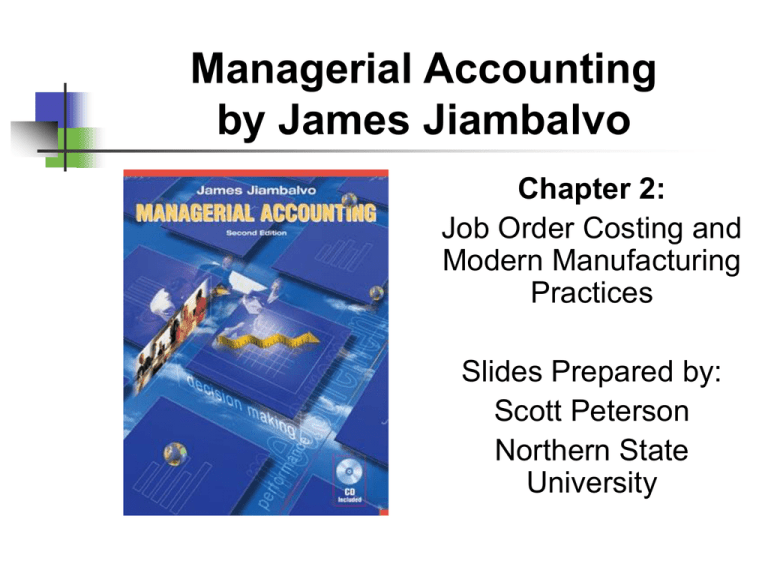
Managerial Accounting
by James Jiambalvo
Chapter 2:
Job Order Costing and
Modern Manufacturing
Practices
Slides Prepared by:
Scott Peterson
Northern State
University
Objectives
1. Distinguish between manufacturing
and nonmanufacturing costs and
between product and period costs.
2. Discuss the three inventory accounts
of a manufacturing firm.
3. Describe the flow of product costs in a
manufacturing firm's accounts.
4. Discuss the types of product costing
systems.
Objectives
(continued)
5. Describe how direct material, direct
labor, and manufacturing overhead are
assigned to jobs.
6. Explain the role of a predetermined
overhead rate in applying overhead to
jobs.
Objectives
(continued)
7. Explain why the difference between
actual overhead and overhead
allocated to jobs using a
predetermined rate is closed to Cost of
Goods Sold or apportioned among
Work in Process Inventory, Finished
Goods Inventory, and Cost of Goods
Sold.
Objectives
(continued)
8. Explain why the difference between
actual overhead and overhead
allocated to jobs using a
predetermined rate is closed to Cost of
Goods Sold or apportioned among
Work in Process Inventory, Finished
Goods Inventory, and Cost of Goods
Sold.
9. Discuss modern manufacturing
practices and how they affect product
costing.
Cost Classifications for
Manufacturing Firms
Manufacturing Costs (product costs): all
costs associated with the production of
goods.
1. Direct Material
2. Direct Labor
3. Manufacturing Overhead
Cost Classifications for
Manufacturing Firms
Nonmanufacturing Costs
Nonmanufacturing Costs (period costs):
all costs not associated with the
production of goods.
1. Selling Costs
2. General and Administrative Costs
Product and Period Costs
Product Costs and Period Costs are
Synonymous with Manufacturing and
Nonmanufacturing costs, respectively.
Product Cost Information in
Financial Reporting and
Decision Making
GAAP (Generally Accepted Accounting
Principles) requires that inventory on
balance sheets and cost of goods sold on
income statements be disclosed
(reported) using Full Cost information.
Balance Sheet Presentation of
Product Costs
1. Raw Materials Inventory.
2. Work in Process Inventory.
3. Finished Goods Inventory.
Flow of Product Costs in
Accounts
Product costs flow from the Direct
Materials, Direct Labor and Manufacturing
Overhead through Work in Process to
Finished Goods Inventory and finally to
Cost of Goods Sold.
Flow of Product Costs in
Accounts
Income Statement Presentation
of Product Costs
When finished goods are sold they are
moved from Finished Goods to Cost of
Goods Sold.
Cost of Goods Manufactured
Cost of Goods Manufactured includes all
costs of goods completed during the
period.
Cost of Goods Sold
Cost of Goods Sold.
Types of Costing Systems
Companies use product costing systems
to measure and record the cost of
manufactured products. Two types:
1. Job-Order Costing System.
2. Process Costing System.
Overview of Job Costs and
Financial Statement Accounts
In a Job-Order Costing System, the three
product costs (materials, labor and
overhead) are related to specific jobs.
Relating Product Costs to Jobs
Job Costs and Financial
Statement Accounts
Flow of Costs in a Job-Order
Costing System
Job-Order Costing System
In Job-Order Costing Systems the primary
document (likely electronic) is called a
Job-Cost Sheet. It is used to accumulate
or capture the following costs:
1. Direct Material Cost.
2. Direct Labor Cost.
3. Manufacturing Overhead.
Direct Materials
A Materials Requisition Form is used to
request the release of materials from
stores inventory into production.
Direct Materials
Direct Labor
Time Tickets are used to associate Direct
Labor with specific Jobs.
Direct Labor
Manufacturing Overhead
Unlike Direct Costs (Direct Materials and
Direct Labor) Manufacturing Overhead is
indirectly traced (allocated) to jobs using
an Overhead Allocation Rate.
Manufacturing Overhead
Assigning Costs to Jobs: A
Summary
Relation Between the Costs of
Jobs and the Flow of Costs
Allocating Overhead to Jobs: A
Closer Look
1. Overhead Allocation Rates
2. Overhead Allocation Base
3. Activity Based Costing (ABC) and
Multiple Overhead Rates
Overhead Allocation Rate
Overhead Allocation Rate =
Overhead Cost
Allocation Base
Overhead Allocation Base
Alternative bases include:
1. Direct labor hours
2. Direct labor cost
3. Machine hours
4. Direct material cost.
Activity-Based Costing (ABC)
and Multiple Overhead Rates
ABC is a method of assigning overhead
based on a number of different allocation
bases (rather than just one). ABC groups
overhead costs into Cost Pools.
Predetermined Overhead Rates
Predetermined Overhead Rate =
Estimate Total Overhead Cost
Estimated Level of Allocation Base
Eliminating Overapplied or
Underapplied Overhead
1. Actual costs (Materials, Labor and
Overhead) are accumulated in the
Manufacturing Overhead Account and
2. Overhead is applied to production
based on the Predetermined
Overhead Rate.
Eliminating Overapplied or
Underapplied Overhead (continued)
1. Unless estimates are perfect, there will
be either a debit or credit balance in
the Manufacturing Overhead account.
2. If actual > applied, a debit balance,
results, thus underapplied overhead.
3. If actual < applied a credit balance,
results, thus overapplied overhead.
Eliminating Overapplied or
Underapplied Overhead (continued)
1. Manufacturing Overhead should have
a zero balance at year-end
2. Often closed it out to Cost of Goods
Sold.
3. Theoretically it should be allocated
between Work in Process, Finished
Goods and Cost of Goods Sold.
Job-Order Costing for Service
Companies
1. Job-Order Costing is also used by
service companies.
2. Examples include hospitals (patients)
and automobile repair firms.
Modern Manufacturing
Practices and Product Costing
Systems
1. Just-in-Time (JIT) Production.
2. Computer-Controlled Manufacturing.
3. Total Quality Management (TQM).
Quick Review Question #1
1. Which of the following is a period
cost?
a. Raw materials costs.
b. Manufacturing plant maintenance.
c. Wages for production line workers.
d. Salary for the vice president of
finance.
Quick Review Answer #1
1. Which of the following is a period
cost?
a. Raw materials costs.
b. Manufacturing plant maintenance.
c. Wages for production line workers.
d. Salary for the vice president of
finance.
Quick Review Question #2
2. Which of the following is a direct
materials cost?
a. Steel for a ship builder.
b. Production supervisor salary for an
auto manufacturer.
c. Factory rent.
d. Pocket protector for company
accountant.
Quick Review Answer #2
2. Which of the following is a direct
materials cost?
a. Steel for a ship builder.
b. Production supervisor salary for an
auto manufacturer.
c. Factory rent.
d. Pocket protector for company
accountant.
Quick Review Question #3
3. Beginning work-in-process plus total
manufacturing costs minus ending
work-in-process equals
a. Cost of materials used.
b. Finished goods inventory.
c. Cost of goods sold.
d. Cost of goods manufactured.
Quick Review Answer #3
3. Beginning work-in-process plus total
manufacturing costs minus ending
work-in-process equals
a. Cost of materials used.
b. Finished goods inventory.
c. Cost of goods sold.
d. Cost of goods manufactured.
Quick Review Question #4
4. Cost of Goods Sold is $200,000,
beginning Finished Goods is $50,000,
ending Finished Goods is $100,000
and ending Work in Process is
$10,000. What is the Cost of Goods
Manufactured?
a. $100,000
b. $250,000
c. $50,000
d. $150,000
Quick Review Answer #4
4. Cost of Goods Sold is $200,000,
beginning Finished Goods is $50,000,
ending Finished Goods is $100,000
and ending Work in Process is
$10,000. What is the Cost of Goods
Manufactured?
a. $100,000
b. $250,000
c. $50,000
d. $150,000
Copyright
© 2004 John Wiley & Sons, Inc. All rights reserved.
Reproduction or translation of this work beyond that
permitted in Section 117 of the 1976 United States
Copyright Act without the express written permission of the
copyright owner is unlawful. Request for further information
should be addressed to the Permissions Department, John
Wiley & Sons, Inc. The purchaser may make back-up
copies for his/her own use only and not for distribution or
resale. The Publisher assumes no responsibility for errors,
omissions, or damages, caused by the use of these
programs or from the use of the information contained
herein.





